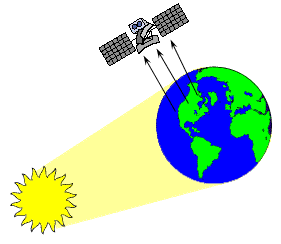Radiometry principle
Microwave remote sensing uses passive microwave radiometers. The microwaves have wavelength ranging from a few kHz to THz. The “passive” term means that it uses microwaves naturally radiated by the observed area (this is different from the radar principle where the sensor transmits a microwave signal towards a target and detects the backscattered radiation).
Satellite passive microwave radiometers measure raw antenna counts from which we determine the antenna temperature and then calculate the brightness temperature of the Earth. Large antennas are used for the various channels of the radiometer, and in operation, each antenna feedhorn passes a hot and cold target in order to provide consistently calibrated raw counts. Brightness temperature is a measure of the radiance of microwave radiation traveling upward from the top of Earth's atmosphere. The conversion from radiometer counts to top-of-the-atmosphere (TOA) brightness temperature is called the calibration process. Several calibration processing steps are required to derive the brightness temperature values.





